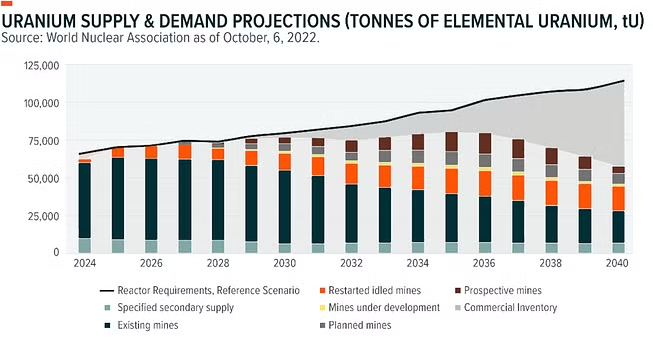Uranium: A multi-decade opportunity
Kenny Arnott and Yianni Gertos explain the dynamics at play in the uranium market and why they are seeing tailwinds for this investment theme over the long term.

Key takeaways:
- Demand for uranium continues to pick up, but a severe shortfall in supply is resulting in a material increase in the spot price.
- The underlying fundamentals are supportive of further long-term growth.
- Environmental policy is a tailwind for demand as commitment to a net-zero future brings about change in the energy mix.
If you were out hiking, it is unlikely you would be compelled to pick up a piece of uranium ore if you came across it – you may not even notice it. The reality is that it looks just like any other rock. However, looks can be deceiving as uranium might just represent one of the most exciting long term investment themes, as well as the world’s best shot at unlocking an abundant source of carbon-free energy.
We’ve been bullish uranium for an extended period of time and when we first looked at this theme five years ago, we could not have imagined the setup that we have today.
Below, we explore the factors and dynamics that make the case for uranium extremely compelling.
A global supply/demand imbalance

Source: Iris
Demand is returning but supply can’t keep up
After three decades of flat nuclear demand, new Chinese and Indian reactors are about to come online, with 60 under construction. These additional reactors are estimated to add more than 15% to world demand for uranium. Further to this, 100 more reactors have been approved, adding a long tail of increasing demand over time as each reactor comes online.
By 2035, global demand for uranium is expected to be 209 million pounds annually, which is estimated to lead to a supply shortfall of 114 million pounds per year.
Partly due to underinvestment and a temporary shift away from nuclear following the Fukushima plant melt down in 2011, no new uranium supply has come online in over a decade. Today, growing demand and insufficient inventories are now being reflected in material increases in spot prices.
Following a low in 2016 of just under $20 p/lb, the spot price is marching back toward its 2007 high (US$140 p/lb), breaking the US$100p/lb threshold already in 2024.
The outlook for supply is not expected to improve as Kazatomprom, the Kazakh company that produces roughly 40% of global uranium supply, warned earlier this year that it is unlikely to meet its production forecasts. Further compounding their supply challenges are delays in the construction of a sulphuric acid plant (used in the refining of uranium ore) that has been pushed out to 2028.
Green energy tail winds?
With global commitments to carbon emissions targets, governments are racing to meet their goals through decarbonisation initiatives. Harnessing renewable energy sources, looking to battery storage and the decommissioning of fossil fuel power generation are being complemented by expansion in nuclear power generation and programs to extend the life of existing reactors.
Nuclear power has been approved within the European Union’s Green Taxonomy, meaning it will be entitled to green energy subsidies, which will undoubtedly make nuclear the foundation of many European nations’ base loads. Meanwhile, at COP28 (the 28th annual Conference of the Parties, a major international climate summit organised by the United Nations Framework Convention on Climate Change (UNFCCC)), 22 countries committed to a three-fold increase in their nuclear capacity by 2050, adding to additional uranium demand.
Nuclear power has long been controversial in Australia – It has been banned in every Australian state and territory since 1999. However, the urgency of modern climate policy has led to renewed interest. The Federal Opposition recently unveiled plans to build reactors on the sites of former coal-fired power stations. While Kazakhstan is the largest producer of uranium, Australia boasts more than double the resources of Kazakhstan[1], another reason Australia may reconsider its position on the matter at some point in the future.
AI – an unexpected demand source
In the wake of a technological leap in artificial intelligence in recent years, attention is now being turned to the growing energy demand from the millions of servers around the world required to enable the technology.
This is clearly on the agenda for tech companies, highlighted by Amazon’s acquisition of a nuclear-powered datacentre from Talen Energy for US$650m. Amazon set a net-zero carbon emissions goal for 2040, with this acquisition helping it to make strides toward that commitment.
This is not the first time that large tech companies have entered commodity markets as Apple has direct supplier agreements in place with cobalt mines to ensure sufficient supplies for its devices’ batteries.
A long-term theme to watch
While we actively manage our exposure to all of our investment themes, and will divest or upweight based on our judgement of opportunities at any time, the uranium theme is one that we feel has incredible underlying fundamentals behind it for the foreseeable future.
For an unexciting rock, we feel it has an exciting and vital role to play in the decades ahead and look forward to uncovering new investment opportunities within this thematic.
[1] https://world-nuclear.org/information-library/nuclear-fuel-cycle/mining-of-uranium/world-uranium-mining-production /

